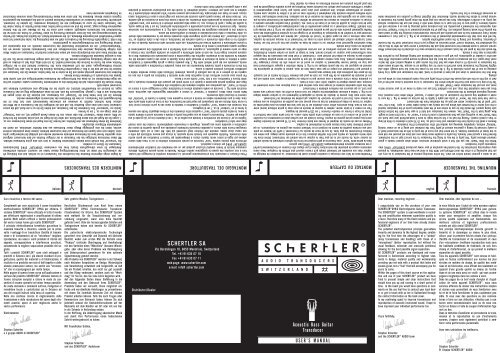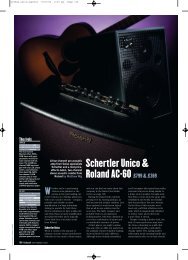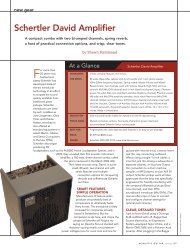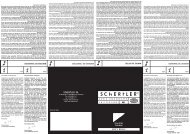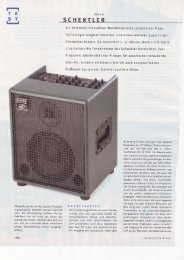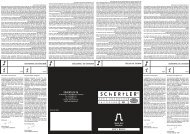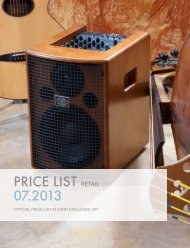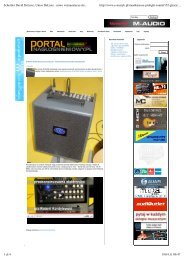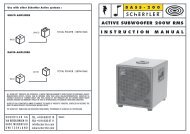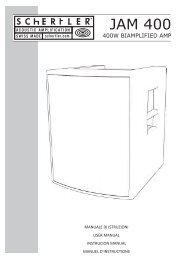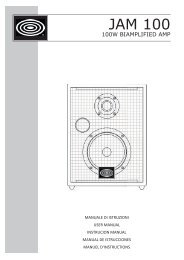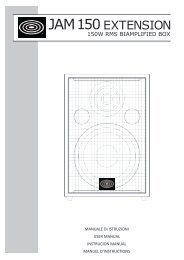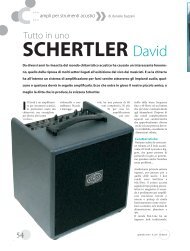schert. acoustic bass guitar - Schertler
schert. acoustic bass guitar - Schertler
schert. acoustic bass guitar - Schertler
You also want an ePaper? Increase the reach of your titles
YUMPU automatically turns print PDFs into web optimized ePapers that Google loves.
<strong>schert</strong>. <strong>acoustic</strong> <strong>bass</strong> <strong>guitar</strong> 7-03-2011 14:50 Pagina 1<br />
MOUNTING THE TRANSDUCER<br />
MONTAGE DU CAPTEUR<br />
MONTAGGIO DEL TRASDUTTORE<br />
MONTIEREN DES TRANSDUCERS<br />
Let us make a general remark before we start. The entire mounting process of the transducer is so very simple<br />
that explaining it is often the most difficult part. With this in mind we have tried, nonetheless, to present<br />
easy step-by-step instructions for the trouble-free operation of your newly purchased SCHERTLER® DYN-G, electrodynamic<br />
<strong>guitar</strong> transducer.<br />
Within the little "black” box you will find a small cylindrical container, which when opened reveals a green<br />
coloured adhesive putty. This putty is the key to fixing the Transducer to the correct spot on the instrument.<br />
Derived from a special inert formula, the putty is reusable many times over and does not present any risk even<br />
to the finest of instrument finishes. In the event that any trace of the putty is left on the instrument itself, it<br />
is easily removed by taking a generous amount of putty from the container and using it as an eraser making<br />
"dabbing” motions, completely removing any residue left after detachment of the transducer.<br />
Remove a small bit of putty from the container and form a ball ca. 1cm (7/16 inch) in diameter (a little bit larger<br />
than a pencil eraser). Placing the ball on a flat surface begin to work it back-and-forth (use your hand, our<br />
little "black” box or anything else you find convenient) in order to form a "worm” ca. 7 cm (23/4 inch) in length.<br />
Now, going back to the "black” box, remove the transducer and hold it in your hand with the bottom (black)<br />
side facing upward. We would like for you to notice one of the most important parts of the transducer located<br />
in the very center of the bottom side where you can clearly see a black rubber insert or spot. This is the "contact”<br />
point of the transducer, which will pick up the vibrations from the instrument.<br />
In your free hand take the "worm” of putty and apply it lightly to the surface as shown in Fig. 1. Be sure to<br />
make a complete ring around the transducer as this will create a "vacuum” effect when later mounted, thus<br />
ensuring improved adhesion to the instrument.<br />
Once you have completed this step, and are confident that you are ready to move on to your musical instrument,<br />
you can put the transducer down ("black” side up).<br />
The first step is to make sure that the surface where the transducer is to be mounted is clean and free of any<br />
dust or oily film as this will only lessen the effect of the putty and may create problems later on while you are<br />
playing.<br />
Now that the instrument is clean and you have it securely in hand, take the transducer and apply it by firmly<br />
pressing on one of the points indicated in Fig. 2. Be sure not to press too hard, but hard enough, while also<br />
slightly twisting the transducer back and forth in order for any trapped air to escape. You will be aware when<br />
the transducer is correctly fit in place when you feel that the center spot is making contact with the instrument.<br />
Once again, it is not necessary to press too hard, but only enough to ensure proper connection. With time,<br />
and after a number of applications, you will gain a certain confidence and feeling allowing you to perform this<br />
operation in less than a minute.<br />
We would also like to point out the basic concept of the transducer once it is attached to the instrument. When<br />
correct contact is made between the instrument body and the transducer’s center spot, we refer to this as having<br />
established the "vibration circuit” which becomes an integral part of the instrument itself for the transfer<br />
of dynamics, frequency and timing to the sound amplification system.<br />
You will also note that the recommended placement of the transducer as in Fig. 2, is just that, a recommendation.<br />
Every instrument has its own personality and particular characteristics including the type of wood used,<br />
the quality of the wood, bracing positions etc. The goal of the optimal placement is to find a "hotspot” that not<br />
only reproduces the instrument’s personality, but also produces sound pleasing to you as a musician and ultimately<br />
listeners. A good way to find this spot is to simply work with a friend and use the transducer, without<br />
any putty, as a doctor’s stethoscope. Here one person can play while the other gently places the transducer in<br />
various places to obtain the desired results. Remember that slightest change in position can sometimes make<br />
an enormous difference in the final results.<br />
Permettez-nous de faire une remarque à caractère général avant de commencer. La procédure de montage du<br />
capteur dans son ensemble est tellement simple qu’il s’avère souvent plus difficile de l’expliquer. Nous avons<br />
néanmoins essayé de présenter des instructions faciles et par étapes afin d’assurer un fonctionnement parfait<br />
à vos nouveaux capteurs électrodynamiques SCHERTLER“ DYN-G pour <strong>guitar</strong>e.<br />
Dans la petite boîte "noire”, vous trouverez un petit récipient en forme de cylindre renfermant du mastic adhésif<br />
de couleur verte. Ce mastic est la clé pour fixer le capteur au bon endroit sur l’instrument. Dérivé d’une formule<br />
inerte spéciale, ce mastic peut être réutilisé plusieurs fois et ne présente aucun danger, pas même aux<br />
finitions d’instrument les plus fines. En cas de trace de mastic sur l’instrument, il suffit de l’enlever en prélevant<br />
une certaine quantité de mastic du récipient et en l’utilisant comme une gomme en «tamponnant», ce qui<br />
permet d’éliminer toute trace laissée après le décollement du capteur.<br />
Prélevez un peu de mastic du récipient et formez une boule d’environ 1cm (7/16 pouces) de diamètre (légèrement<br />
plus grosse qu’une gomme de crayon). Placez la boule sur une surface plate et commencez à la travailler<br />
en avant et en arrière (à la main en utilisant notre petite boîte «noire» ou tout autre objet vous facilitant la<br />
tâche) de façon à former un «boudin» d’environ 7 cm (23/4 pouces) de longueur.<br />
Pour en revenir à la boîte «noire», enlever le capteur et tenez-le en main avec la partie inféieure (noire) orientée<br />
vers le haut. Nous aimerions attirer votre attention sur le fait que l’une des pièces les plus importantes du<br />
capteur se trouve au milieu précisément du bas où vous pouvez voir une pastille en caoutchouc ou une marque<br />
de couleur noire. Ceci est le point de «contact» du capteur, qui prélève les vibrations de l’instrument.<br />
Avec votre main libre, prenez le «boudin» de mastic et appliquez-le légèrement sur la surface comme indiqué<br />
sur la Fig. 1. Veillez à entourer complètement le capteur car ceci créera un effet de «vide» lorsqu’il sera monté<br />
plus tard, ce qui assurera une meilleure adhésion à l’instrument.<br />
Une fois cette opération achevée et lorsque vous vous sentirez prêt à vous déplacer avec votre instrument de<br />
musique, vous pouvez déposer le capteur (côté «noir» vers le haut).<br />
La première chose à faire consiste à vous assurer que la surface sur laquelle le capteur sera monté est propre<br />
et exempte de poussière ou de film gras, car cela ne peut que diminuer l’effet du mastic et est susceptible<br />
de poser des problèmes plus tard lorsque vous jouerez.<br />
A présent que l’instrument est propre et que vous l’avez bien en main, prenez le capteur et appliquez-le fermement<br />
en appuyant sur l’un des points indiqués sur la Fig. 2. Faites attention à appuyer suffisamment mais<br />
pas trop en faisant tourner légèrement le capteur en avant et en arrière afin de laisser s’échapper l’air<br />
éventuellement présent. Vous vous rendrez compte du fait que le capteur est en bonne position lorsque vous<br />
sentirez que la marque au milieu fait contact avec l’instrument. Il n’est donc pas nécessaire de trop appuyer<br />
mais suffisamment pour assurer un contact correct. Avec le temps et après un certain nombre d’utilisations,<br />
vous aurez acquis une certaine confiance et une certaine sensibilité qui vous permettront d’effectuer cette<br />
opération en moins d’une minute.<br />
Nous souhaitons également nous attarder sur la notion de base du capteur une fois qu’il est fixé sur l’instrument.<br />
Lorsqu’un contact adéquat est assuré entre le corps de l’instrument et la marque centrale du capteur,<br />
nous nous référons à ceci en ayant établi le "circuit de vibration”, qui devient une partie intégrante de l’instrument<br />
pour le transfert de la dynamique, la fréquence et le réglage vers le système d’amplification des sons.<br />
Veuillez également prendre note du fait que la position conseillée pour le capteur sur la Fig. 2 n’est donnée qu’à<br />
titre indicatif. Chaque instrument a sa propre personnalité et des caractéristiques particulières, y compris le<br />
type de bois utilisé, la qualité du bois et la façon de le tenir, etc. L’objectif d’une position optimale consiste à<br />
trouver la «meilleure position» en mesure non seulement de refléter la personnalité de l’instrument mais de produire<br />
aussi un son agréable pour les oreilles du musicien et de ses auditeurs. Une bonne méthode pour trouver<br />
cette meilleure position consiste tout simplement à travailler avec un ami et à utiliser le capteur, sans mastic,<br />
comme un stéthoscope médical. Une personne peut alors jouer tandis que l’autre place soigneusement le<br />
capteur à différents endroits pour obtenir les résultats voulus. N’oubliez pas que le moindre changement de position<br />
peut parfois produire une énorme différence au niveau du résultat final.<br />
Prima d'iniziare, è necessario fare un'osservazione generale. La procedura completa di montaggio del trasduttore<br />
è così semplice che spesso la spiegazione sembra difficile. Tenendo in mente questo concetto, abbiamo<br />
comunque tentato di fornire semplici istruzioni graduali per un uso immediato dei trasduttori elettrodinamici<br />
SCHERTLER® DYN-G per chitarra acquistati.<br />
All'interno della piccola scatola "nera" troverete un piccolo contenitore cilindrico in cui si trova dello stucco<br />
adesivo per legno di colore verde. Questo stucco è indispensabile per fissare il trasduttore nel punto esatto<br />
dello strumento. Prodotto seguendo una formula inerte speciale, lo stucco può essere riutilizzato più volte e<br />
non causa alcun danno, neanche alle rifiniture degli strumenti più belli. Nel caso in cui sullo strumento<br />
rimangano tracce dello stucco, è possibile rimuoverle facilmente prendendo una grande quantità di stucco dal<br />
contenitore e usandola come una gomma, sfregando e rimuovendo completamente i residui che sono rimasti<br />
dopo aver tolto il trasduttore.<br />
Togliete un po' di stucco dal contenitore e formate una pallina di ca. 1 cm di diametro (un po' più grande di una<br />
gomma per matita). Posizionate la pallina su una superficie piatta e iniziate a lavorarla avanti e indietro (usate<br />
la mano, la nostra piccola scatola "nera" o qualsiasi altro strumento che si ritiene adeguato) finché non assume<br />
la forma di un "cordone" di ca. 7 cm di lunghezza.<br />
Ora, tornando alla scatola "nera", togliete il trasduttore e tenetelo in mano con la parte inferiore (nera) rivolta<br />
verso l'alto. Notate uno dei componenti più importanti del trasduttore, che si trova al centro della parte inferiore,<br />
dove si può chiaramente vedere un inserto o un'area in gomma nera. Questo è il punto di "contatto" che<br />
riceverà le vibrazioni dallo strumento.<br />
Nella vostra mano libera, prendete il "cordone" di stucco e applicatelo leggermente alla superficie, come<br />
mostrato nella Fig. 1. Lavorate un anello completo attorno al trasduttore: dopo il montaggio verrà a crearsi un<br />
effetto di "vuoto”, che garantisce una migliore adesione del trasduttore allo strumento.<br />
Dopo aver eseguito questa operazione e quando ci si sente pronti per passare allo strumento musicale, è possibile<br />
fissare il trasduttore, con il lato "nero" rivolto verso il <strong>bass</strong>o.<br />
Per prima cosa occorre verificare che la superficie dove verrà montato il traduttore sia pulita e che non sia<br />
coperta né da polvere o né da una pellicola di grasso, altrimenti l'efficacia dello stucco verrebbe ridotta e<br />
potrebbero verificarsi problemi quando si suona.<br />
Ora che lo strumento è pulito, tenetelo fermamente con una mano, prendete il trasduttore e applicatelo saldamente,<br />
premendo uno dei punti indicati nelle Fig. 2. Non premete troppo e girate leggermente il trasduttore<br />
avanti e indietro, in modo da eliminare le eventuali bolle d'aria. Quando si sente che il punto centrale del trasduttore<br />
fa contatto con lo strumento, significa che l'apparecchio è stato posizionato correttamente. Non è necessario<br />
premere troppo forte, ma solo in modo sufficiente a garantire un contatto adeguato. Con il tempo, e<br />
dopo un certo numero di applicazioni, si acquisirà una certa familiarità e una sensibilità che consentiranno di<br />
eseguire questa operazione in meno di un minuto.<br />
Ci preme sottolineare il concetto di base del trasduttore, una volta montato sullo strumento. Quando si crea un<br />
contatto tra il corpo dello strumento e il punto centrale del trasduttore, si dice che è stato stabilito un "circuito<br />
di vibrazione", che diventa una parte integrante dello strumento stesso per la trasmissione della dinamica,<br />
della frequenza e della sincronizzazione al sistema di amplificazione del suono.<br />
Si noterà che la posizione consigliata del trasduttore, mostrata nella Fig. 2, è semplicemente una raccomandazione.<br />
Ogni strumento ha una propria personalità e caratteristiche particolari, tra cui il tipo di legno usato,<br />
la qualità del legno, i punti di rinforzo, ecc. Lo scopo della posizione ottimale è di trovare una "area sensibile”<br />
che non solo riproduca la personalità dello strumento, ma anche il suono che piace al musicista ed agli ascoltatori.<br />
Un buon modo per trovare questo punto consiste nel lavorare con degli amici e usare il trasduttore, senza<br />
stucco, come se fosse uno stetoscopio. Una persona può suonare mentre l'altra posiziona delicatamente il trasduttore<br />
in vari punti, per ottenere i risultati desiderati. Si ricordi che una piccolissima variazione di posizione<br />
può a volte generare risultati finali molto diversi.<br />
Zu Beginn einige allgemeine Hinweise: Das Installieren des Transducers ist so einfach, daß eine Erklärung oft<br />
der schwierigste Teil dabei ist. Unter Berücksichtigung dessen haben wir versucht, einfache schrittweise<br />
Anleitungen für einen störungsfreien Einsatz Ihres neu erworbenen SCHERTLER® DYN-G Electrodynamic<br />
Transducers für Gitarre zu erstellen.<br />
Die "schwarze" Box enthält einen kleinen zylindrischen Behälter, in dem sich eine grüne Knetmasse befindet.<br />
Mit dieser Knetmasse befestigen Sie den Transducer in der richtigen Position auf dem Instrument. Aufgrund<br />
einer speziellen Formel kann die Knetmasse mehrmals verwendet werden und schädigt die hochwertigen Lacke<br />
nicht. Sollten sich noch Spuren der Knetmasse auf dem Instrument befinden, können diese problemlos entfernt<br />
werden, indem Sie eine großzügige Menge dieser Knetmasse aus dem Behälter entnehmen, um damit die<br />
verbleibenden Kittspuren abzutupfen.<br />
Entnehmen Sie etwas Knetmasse aus dem Behälter, und formen Sie eine Kugel mit einem Durchmesser von ca.<br />
1. Legen Sie die Kugel auf eine ebene Oberfläche, und rollen Sie die Kugel vor und zurück (nehmen Sie Ihre Hand<br />
zur Hilfe, unsere kleine "schwarze" Box oder etwas, das für diesen Zweck geeignet ist), um eine "Schlange"<br />
mit einer Länge von ca. 7 cm zu formen.<br />
Zurück zur "schwarzen" Box: Entnehmen Sie den Transducer, und halten Sie ihn so in der Hand, daß die untere<br />
(schwarze) Seite nach oben zeigt. Beachten Sie, daß sich der wichtigste Teil des Transducers in der Mitte der<br />
unteren Seite befindet, deutlich zu erkennen am schwarzen Gummieinsatz oder -teil. Dies ist der<br />
Berührungspunkt des Transducers, an dem die Vibrationen des Instruments aufgenommen werden.<br />
Nehmen Sie mit Ihrer freien Hand die "Schlange" aus Knetmasse, und drücken Sie sie leicht gegen die<br />
Oberfläche, wie in Abb. 1 gezeigt. Vergewissern Sie sich, daß Sie einen vollständigen Ring um den Transducer<br />
legen, da dadurch ein Vakuumeffekt entsteht, der später bei der Montage eine verbesserte Adhäsion zum<br />
Instrument sicherstellt.<br />
Weiter müssen Sie sicherstellen, daß die Oberfläche des zu montierenden Transducers sauber, staubfrei und frei<br />
von öligen Rückständen ist, da diese das Haftvermögen der Knetmasse beeinträchtigen und evtl. später beim<br />
Spielen des Instruments zu Problemen führen können.<br />
Nachdem das Instrument gereinigt wurde und Sie es sicher in der Hand halten, nehmen Sie den Transducer und<br />
drücken ihn fest auf eine der in Abb. 2 dargestellten Positionen. Drücken Sie nicht zu fest, aber fest genug mit<br />
leichten Drehbewegungen, damit die Luft entweichen kann. Der Transducer befindet sich in der richtigen<br />
Position, wenn der Taster im Zentrum das Instrument berührt. Es ist nicht nötig, allzu fest zu drücken, es muß<br />
nur eine richtige Verbindung hergestellt werden. Mit der Zeit und nach einigen Versuchen lernen Sie, wie Sie<br />
dies in wenigen Sekunden durchführen können.<br />
Wir möchten Ihnen auch das Grundprinzip eines auf einem Instrument montierten Transducers vorstellen. Wenn<br />
eine richtige Verbindung zwischen dem Instrumentkörper und dem Gummieinsatz besteht, nennen wir das<br />
"Vibrationskreislauf", der ein wesentlicher Bestandteil des Instruments darstellt, um eine dynamische und<br />
präzise Übertragung zum Verstärkungssystem zu gewährleisten.<br />
Die in Abb. 2 dargestellte Plazierung des Transducers stellt nur eine Empfehlung dar. Jedes Instrument hat seine<br />
eigene Persönlichkeit und besondere Merkmale, z.B. die verwendete Holzart, die Qualität des Holzes, die Position<br />
der Saitenverspannung usw. Das Ziel einer optimalen Plazierung ist, einen "Hotspot" zu finden, der nicht nur die<br />
Persönlichkeit des Instruments wiedergibt, sondern auch einen für Sie als Musiker und für Ihre Zuhörer<br />
angenehmen Klang erzeugt. Lassen Sie sich von einem Freund helfen, diese ideale Position zu finden, indem Sie<br />
den Transducer (ohne ihn zuvor zu befestigen) wie ein Stethoskop verwenden. Sie spielen Ihr Instrument,<br />
während Ihr Freund den Transducer an verschiedenen Positionen plaziert, so daß Sie problemlos das gewünschte<br />
Ergebnis erzielen können. Bedenken Sie, daß schon eine kleine Positionsänderung einen enormen Unterschied<br />
im Endergebnis ausmachen kann.<br />
italiano deutsch english français<br />
Caro musicista e tecnico del suono. . .<br />
Sehr geehrte Musiker, Toningenieure . . .<br />
Dear musician, recording engineer . . .<br />
Cher musicien, cher ingénieur du son …<br />
Complimenti per aver acquistato il nuovo trasduttore<br />
elettro-dinamico SCHERTLER® DYN-G per chitarra. Il<br />
sistema SCHERTLER® viene utilizzato in tutto il mondo<br />
per effettuare registrazioni e amplificazioni di ottima<br />
qualità. Molti solisti raffinati e tecnici professionisti<br />
del nostro tempo hanno già scelto SCHERTLER®.<br />
Il principio elettrodinamico brevettato garantisce la<br />
massima linearità e dinamica, unendo per la prima<br />
volta i vantaggi di un trasduttore (facilità di trasmissione<br />
e di trattamento) ad un "microfono" (migliore<br />
riproduzione, ma senza i soliti problemi di ritorno del<br />
segnale, sovrapposizione e interferenza acustica),<br />
consentendo la migliore separazione possibile del segnale.<br />
Tutti i prodotti SCHERTLER® sono stati sviluppati e<br />
prodotti in Svizzera con i più elevati standard di progettazione,<br />
qualità dei materiali e di fabbricazione. Il<br />
risultato è un prodotto non solo di bell'aspetto e dalle<br />
elevate prestazioni sonore, ma anche uno "strumento"<br />
che vi accompagnerà per molto tempo.<br />
Nelle pagine di questo breve corso sull'applicazione e<br />
sull'uso del prodotto SCHERTLER® abbiamo tentato di<br />
fornire istruzioni semplici e chiare in modo da consentirvi<br />
di essere operativi nel minor tempo possibile.<br />
Se avete domande o commenti sull'uso, rivolgetevi al<br />
rivenditore locale o contattateci qui in Svizzera ad<br />
uno dei recapiti indicati nella terza di copertina.<br />
Nella mia continua ricerca di miglioramento della<br />
trasmissione e della riproduzione del suono degli strumenti<br />
acustici, spero di aver migliorato anche le<br />
vostre performance.<br />
Distintamente<br />
Stephan <strong>Schertler</strong><br />
e il gruppo AUDIO di SCHERTLER®<br />
Herzlichen Glückwunsch zum Kauf Ihres neuen<br />
SCHERTLER® DYN-G Electrodynamic Transducer<br />
(Tonabnehmer) für Gitarre. Das SCHERTLER®-System<br />
wird weltweit für die Tonaufzeichnung und -verstärkung<br />
eingesetzt, wenn eine hohe Qualität<br />
gefordert wird. Viele der herausragenden Solisten und<br />
Toningenieure haben sich bereits für SCHERTLER®<br />
entschieden.<br />
Die patentierte elektrodynamische Technologie<br />
garantiert eine Linearität und Dynamik mit höchster<br />
Qualität, wobei zum ersten Mal die Vorteile eines<br />
"Pickups" (einfache Übertragung und Handhabung)<br />
mit den Vorteilen eines "Mikrofons" (bessere Wiedergabe,<br />
aber ohne deren Probleme wie Rückkopplung<br />
und Uebersprechen) gemeinsam für eine optimale<br />
Signaltrennung genutzt werden.<br />
Alle Produkte von SCHERTLER® werden in der Schweiz<br />
nach höchsten Ansprüchen an Design, Materialgüte<br />
und Verarbeitung entwickelt und hergestellt, so daß<br />
Sie ein Produkt erhalten, das nicht nur gut aussieht<br />
und den Klang verbessert, sondern auch ein "Werkzeug"<br />
für Sie ist, das Sie viele Jahre begleiten wird.<br />
Auf den folgenden Seiten dieser Einführung in die<br />
Anwendung und den Gebrauch Ihres SCHERTLER®-<br />
Produkts haben wir versucht, Ihnen möglichst einfache<br />
und verständliche Anleitungen zu präsentieren,<br />
mit denen Sie innerhalb kürzester Zeit mit diesem<br />
Produkt arbeiten können. Falls Sie noch Fragen oder<br />
Kommentare zum Gebrauch haben, können Sie sich<br />
jederzeit anhand der Kontaktinformationen auf der<br />
Rückseite mit dem Händler vor Ort oder mit uns hier<br />
in der Schweiz in Verbindung setzen.<br />
In der Hoffnung, die Uebertragung akustischer Musik<br />
und damit Ihre Performance einen bedeutenden<br />
Schritt weitergebracht zu haben.<br />
Mit freundlichen Grüßen,<br />
Stephan <strong>Schertler</strong><br />
und das SCHERTLER® Audioteam<br />
Distributor/Dealer<br />
SCHERTLER SA<br />
Via Beroldingen 18, 6850 Mendrisio, Switzerland<br />
Tel. +41-91-630 07 10<br />
Fax +41-91-630 07 11<br />
web-page: www.<strong>schert</strong>ler.com<br />
e-mail: info@ <strong>schert</strong>ler.com<br />
A U D I O T R A N S D U C E R S<br />
S W I T Z E R L A N D<br />
Acoustic Bass Guitar<br />
Transducer<br />
USER’S MANUAL<br />
R<br />
TM<br />
I congratulate you on the purchase of your new<br />
SCHERTLER®DYN-G Electrodynamic Guitar Transducer.<br />
The SCHERTLER® system is used worldwide in recording<br />
and amplification whenever superlative quality is<br />
a must. Therefore many of the finest soloists and professional<br />
engineers of our time have already chosen<br />
SCHERTLER®.<br />
The patented electrodynamical principle guarantees<br />
linearity and dynamics to the highest degree, combining<br />
for the first time the advantages of a "pickup"<br />
(easy transmission and handling) with those of a<br />
"microphone" (better reproduction, but without the<br />
usual feedback, voiceover and crosstalk problems)<br />
allowing for the best possible signal seperation.<br />
All SCHERTLER® products are developed and manufactured<br />
in Switzerland according to highest standards<br />
in design, material quality and workmanship<br />
providing you not only with a product that looks and<br />
sounds great, but a "tool” that will accompany you for<br />
years to come.<br />
Within the pages of this short course on the application<br />
and use of your SCHERTLER® product we have<br />
tried to present simple and clear instructions that<br />
should have you up and running in a short period of<br />
time. In the event you would have questions or comments<br />
on the use feel free to contact your local dealer<br />
or get in touch with us her in Switzerland through<br />
the contact information on the back cover.<br />
In my continuing quest to improve transmission and<br />
reproduction of <strong>acoustic</strong> instrument sound, I hope to<br />
have improved your individual performance too.<br />
Yours faithfully,<br />
Stephan <strong>Schertler</strong><br />
and the SCHERTLER® AUDIO team<br />
Je vous félicite pour l’achat de votre nouveau capteur<br />
électro-dynamique SCHERTLER® DYN-G pour <strong>guitar</strong>e.<br />
Le système SCHERTLER® est utilisé dans le monde<br />
entier pour enregistrer et amplifier, chaque fois<br />
qu’une qualité supérieure est fondamentale. Les<br />
meilleurs solistes et ingénieurs professionnels<br />
actuels ont déjà choisi SCHERTLER®.<br />
Son principe électrodynamique breveté garantit la<br />
linéarité et la dynamique au niveau le plus élevé,<br />
alliant pour la première fois les atouts d’un «pick-up»<br />
(facilité de transmission et de maniement) et ceux<br />
d’un «microphone» (meilleure reproduction mais sans<br />
les habituels problèmes de feed-back, de voix hors<br />
champ et d’interférence), ce qui permet la meilleure<br />
séparation du signal possible.<br />
Tous les appareils SCHERTLER® sont conçus et fabriqués<br />
en Suisse conformément aux normes les plus<br />
strictes en matière de design, de qualité des matériaux<br />
et de fabrication, vous offrant non seulement un<br />
appareil d’une grande qualité au niveau de l’esthétique<br />
et du son mais aussi un «outil» qui vous accompagnera<br />
longtemps dans les années à venir.<br />
Dans les pages de ce bref mode d’emploi et d’application<br />
de votre appareil SCHERTLER®, nous nous<br />
sommes efforcés de donner des instructions simples<br />
et claires vous permettant de vous familiariser avec<br />
lui et de le faire fonctionner le plus rapidement possible.<br />
Si vous avez des questions ou des commentaires<br />
à faire sur son utilisation, n’hésitez pas à contacter<br />
votre concessionnaire local ou de nous contacter<br />
en Suisse à l’aide du coupon d’information figurant<br />
au dos.<br />
Dans la tentative d’améliorer en permanence la transmission<br />
et la reproduction du son d’instruments<br />
sonores, j’espère avoir également contribué à améliorer<br />
votre performance personnelle.<br />
Avec mes salutations les meilleures.<br />
Stephan <strong>Schertler</strong><br />
Et l’équipe SCHERTLER® AUDIO
<strong>schert</strong>. <strong>acoustic</strong> <strong>bass</strong> <strong>guitar</strong> 7-03-2011 14:50 Pagina 2<br />
USING THE TRANSDUCER UTILISATION DU CAPTEUR USO DEL TRASDUTTORE VERWENDEN DES TRANSDUCERS<br />
Max Min<br />
λ≈3m<br />
Fig. 1<br />
The unique characteristics of the SCHERTLER®<br />
Transducer provide you with a device with very low<br />
impedance and balanced signal ouput. This lessens<br />
the probability of having problems such as line noise,<br />
humming and interference (i.e. radio noise), even if<br />
very long cables are used. Thanks to the transducer's<br />
high dynamics, transducer noise is kept to a minimum.<br />
Since the transducer has a flat frequency response<br />
we don’t recommend trying to improve the sound<br />
through equalization. As necessary you can adjust<br />
the mounting position of the transducer to control<br />
the sound. However, to reduce certain frequencies at<br />
around XXX Hz, a parametric equalizer could be helpful<br />
to give the sound more transparency. (The<br />
SCHERTLER® PRE-A Acoustic Preamp is provided with<br />
such a filter).<br />
The SCHERTLER® Transducer can be connected in<br />
several different ways, three of which are listed<br />
below:<br />
1) Directly to the mixer or a microphone-amp with<br />
balanced XLR-Inputs (Canon). This will be the most<br />
customary way to amplify most instruments. This is<br />
especially helpful during studio recording as it guarantees<br />
highest fidelity, but also in "live" performances<br />
where you have the possibility to play directly<br />
into the house sytem or concert set-up.<br />
2) Even if there is no PA/mixer system available you<br />
still shouldn’t miss out on the advantages that a "full<br />
range" speaker system offers. You can use the<br />
SCHERTLER® PRE-A Acoustic Preamp in conjunction<br />
with the transducer: this device is musically and technically<br />
synchronized to the SCHERTLER® Transducer<br />
and provides a preamplified signal (+20dB) for connection<br />
to any power-amp or active speaker. Using<br />
our original SCHERTLER® PUB 2/280 or 3/400, very<br />
compact, high quality, two and three way active loudspeakers<br />
will obtain surprising results.<br />
3) The transducer can also be connected to any<br />
<strong>guitar</strong> amp (using an adapter or cable canon/jack).<br />
Yet, one must never forget that most instrument<br />
amplifiers don’t have the ability to reproduce an<br />
<strong>acoustic</strong> instrument sound correctly. The<br />
SCHERTLER® Transducer provides a very <strong>acoustic</strong>,<br />
microphone-like signal, which needs no additional<br />
improvement at all (amp-character, equalizer) unlike<br />
piezoelectric pickups. Therefore you should always<br />
use amplifiers and speaker systems that are best for<br />
piano or voice too. Should you be in a situation where<br />
you are forced to use a <strong>bass</strong> or <strong>guitar</strong> amplifier, we<br />
recommend the use of the Acoustic Preamp, PRE-A,<br />
plugged into the "effects return" (or "slave in") of<br />
the amplifier, which should by-pass the system preamp<br />
of the amplifier, which generally manipulates the<br />
input signal generating a more electric sound.<br />
Les caractéristiques uniques du capteur SCHERTLER®<br />
vous donnent un dispositif ayant une très faible impédance<br />
et une sortie de signal équilibrée. Ceci limite<br />
la probabilité d’avoir des problèmes tels que bruit de<br />
ligne, bourdonnements et interférences (par exemple<br />
bruit de radio), même si de très longs câbles sont utilisés.<br />
Grâce à la haute dynamique du capteur, le bruit<br />
de ce dernier est limité au minimum.<br />
Etant donné que le capteur a une réponse plate à la<br />
fréquence, nous déconseillons de tenter d’améliorer<br />
le son par égalisation. Si nécessaire, vous pouvez<br />
adapter la position de montage du capteur pour contrôler<br />
le son. Toutefois, pour réduire certaines fréquences<br />
à environ XXX Hz, un égalisateur paramétrique<br />
pourrait être utile pour donner plus de transparence<br />
au son (Le modèle SCHERTLER® PRE-A<br />
Acoustic Preamp est doté d’un tel filtre).<br />
Le capteur SCHERTLER® peut être connecté de différentes<br />
façons, dont trois sont énumérées ci-après:<br />
1) Directement au mélangeur ou à un ampli de microphone<br />
avec des entrées XLR équilibrées (Canon).<br />
C’est la méthode la plus couramment adoptée pour<br />
amplifier la plupart des instruments. Ceci est particulièrement<br />
utile pendant un enregistrement en studio<br />
car cela garantit la plus haute fidélité mais aussi<br />
des performances en "direct" où vous avez la possibilité<br />
de jouer directement en milieu familial ou en<br />
concert.<br />
2) Même en l’absence de système de mixage PA, il<br />
ne faut pas oublier les avantages offerts par un système<br />
de haut-parleur "complet". Vous pouvez utiliser<br />
le préamplificateur sonore SCHERTLER® PRE-A en<br />
même temps que le capteur: cet appareil est synchronisé<br />
musicalement et techniquement sur le capteur<br />
SCHERTLER® et émet un signal préamplifié (+20dB)<br />
pour la connexion à n’importe quel amplificateur ou<br />
haut-parleur actif. En utilisant nos appareils originaux<br />
SCHERTLER® PUB 2/280 ou 3/400, très compacts, de<br />
haute qualité, des haut-parleurs à deux et à voies<br />
obtiendront des résultats surprenants.<br />
3) Le capteur peut également être connecté à n’importe<br />
quel amplificateur de <strong>bass</strong>e (en utilisant un<br />
adaptateur ou câble canon/prise). Il ne faut cependant<br />
jamais oublier que la plupart des amplificateurs<br />
de <strong>bass</strong>e n’ont pas la possibilité de reproduire correctement<br />
le son d’un instrument sonore. Le capteur<br />
SCHERTLER® fournit un signal très acoustique, similaire<br />
à celui d’un microphone, qui n’a besoin d’aucune<br />
autre amélioration (caractère ampli, égalisateur) au<br />
contraire des pick-ups piézo-électriques. Vous devez<br />
par conséquent toujours utiliser des amplificateurs et<br />
des haut-parleurs les mieux adaptés également pour<br />
le piano ou la voix car la <strong>bass</strong>e acoustique ressemble<br />
plus à la voix humaine. Si vous vous trouvez dans une<br />
situation où vous êtes contraint d’utiliser un amplificateur<br />
de <strong>bass</strong>e, nous vous conseillons d’utiliser le<br />
préamplificateur acoustique PRE-A branché dans les<br />
"effets retour" (ou "slave in") de l’amplificateur, qui<br />
devrait ignorer le préamplificateur du système de<br />
l’amplificateur, qui manipule généralement le signal<br />
d’entrée générant un son plus électrique.<br />
Le caratteristiche uniche del trasduttore<br />
SCHERTLER® ne fanno un dispositivo con un'impedenza<br />
molto <strong>bass</strong>a e un'uscita del segnale bilanciata.<br />
Queste caratteristiche diminuiscono l'insorgere di<br />
problemi come il disturbo della linea, il ronzio e l'interferenza<br />
(ovvero il disturbo radio), anche quando si<br />
usano cavi molto lunghi. Grazie all'elevata dinamica<br />
del trasduttore, i disturbi vengono ridotti al minimo.<br />
Poiché il trasduttore ha una risposta di frequenza<br />
piatta, non si consiglia di provare a migliorare il<br />
suono tramite equalizzazione. Se necessario, è possibile<br />
regolare la posizione di montaggio del trasduttore<br />
per controllare il suono. Per ridurre alcune frequenze<br />
a circa XXX Hz, un equalizzatore parametrico<br />
può essere utile per dare al suono una trasparenza<br />
maggiore (il preamplificatore acustico SCHERTLER®<br />
PRE-A è provvisto di tale filtro).<br />
Il trasduttore SCHERTLER® può essere collegato in<br />
numerosi modi diversi, tre dei quali elencati qui di<br />
seguito:<br />
1) Direttamente al mixer o ad un amplificatore microfonico<br />
con ingressi XLR bilanciati. Questo è il tipo più<br />
frequente di amplificazione per la maggior parte degli<br />
strumenti. Tale procedura è particolarmente utile sia<br />
durante la registrazione in studio, perché garantisce<br />
la massima fedeltà, sia nell’ esibizione "dal vivo"; di<br />
conseguenza, si può suonare direttamente mediante<br />
un sistema casalingo o in una configurazione da concerto.<br />
2) Anche se non si dispone di alcun PA/sistema di<br />
missaggio, non si perdono i vantaggi offerti da un sistema<br />
"completo" di altoparlanti. Con il trasduttore<br />
è possibile usare il preamplificatore acustico<br />
SCHERTLER® PRE-A: questo dispositivo è sincronizzato<br />
a livello musicale e tecnico al trasduttore<br />
SCHERTLER® e fornisce un segnale preamplificato<br />
(+20dB) per il collegamento a qualsiasi amplificatore<br />
o altoparlante attivo. Usando il nostro SCHERTLER®<br />
PUB 2/280 o 3/400 originale, molto compatto, di elevata<br />
qualità, con tre altoparlanti attivi a due e a tre<br />
vie, si ottengono risultati sorprendenti.<br />
3) Il trasduttore può inoltre essere collegato a qualsiasi<br />
amplificatore per <strong>bass</strong>o (usando un adattatore<br />
o un cavo canon/jack). Non si deve però mai dimenticare<br />
che la maggior parte degli amplificatori per<br />
<strong>bass</strong>o non riproducono correttamente il suono di uno<br />
strumento acustico. Il trasduttore SCHERTLER® fornisce<br />
un segnale di tipo microfonico, molto acustico,<br />
che non richiede alcun miglioramento aggiuntivo<br />
(amplificatore, equalizzatore), diversamente dai trasduttori<br />
piezoelettrici. Pertanto devono essere usati<br />
sempre amplificatori e altoparlanti ottimali anche per<br />
il pianoforte e la voce, perché il <strong>bass</strong>o acustico è<br />
molto simile alla voce umana. Se siete costretti ad<br />
impiegare un amplificatore per <strong>bass</strong>o, si consiglia di<br />
usare il preamplificatore PRE-A, collegato all’ingresso<br />
secondario dell'amplificatore, che dovrebbe bypassare<br />
il preamplificatore .<br />
Durch die einmaligen Merkmale des SCHERTLER®<br />
Transducers erhalten Sie ein Gerät mit sehr geringer<br />
Impedanz und symmetrischem Signalausgang. Dies<br />
reduziert die Wahrscheinlichkeit, daß Probleme<br />
auftreten wie Leitungs-, Brumm- und Störgeräusche<br />
(z.B. Radiolärm) - auch dann, wenn lange Kabel verwendet<br />
werden. Dank der dynamischen Technologie<br />
des Transducers werden die Eigengeräusche des<br />
Transducers auf ein Minimum reduziert.<br />
Da der Transducer einen flachen Frequenzbereich<br />
aufweist, empfehlen wir nicht, den Klang mit Hilfe<br />
eines Equalizers zu verbessern. Sie können zur<br />
Klangsteuerung gegebenenfalls die Montageposition<br />
des Transducers anpassen. Um jedoch die Resonanzfrequenzen<br />
Ihres Instruments (180 Hz bis 250Hz) zu<br />
verringern, ist ein parametrischer Equalizer für einen<br />
transparenteren Klang sehr hilfreich. (Der<br />
SCHERTLER® PRE-A Acoustic Preamp ist mit diesem<br />
Filter ausgestattet).<br />
Der SCHERTLER® Transducer kann auf verschiedene<br />
Weise angeschlossen werden. Davon werden drei<br />
Möglichkeiten im folgenden beschrieben:<br />
1) Direkt an das Mischpult oder einen Mikrofonverstärker<br />
mit symmetrischen XLR-Eingängen (Canon).<br />
Diese Anschlussart dürfte am meisten zur Anwendung<br />
kommen, da keine weiteren Geräte gebraucht<br />
werden. Dies ist auch dank hoher Wiedergabetreue<br />
besonders hilfreich bei Studioaufzeichnungen, aber<br />
auch bei Live-Auftritten, bei denen Sie die Möglichkeit<br />
haben, direkt über das hauseigene System oder<br />
Konzerteinrichtungen zu spielen.<br />
2) Sogar wenn kein PA/Mischpult zur Verfügung<br />
steht, sollten Sie sich nicht die Vorteile eines "kompletten"<br />
Lautsprechersystems entgehen lassen. Sie<br />
können den SCHERTLER® PRE-A Acoustic Preamp<br />
zusammen mit dem Transducer verwenden: Dieses<br />
Gerät ist musikalisch und technisch auf den<br />
SCHERTLER® Transducer eingestellt und liefert ein<br />
vorverstärktes Signal (+20dB) für jede beliebige<br />
Endstufe bzw. Aktivlautsprecher. Wenn Sie unsere<br />
originalen SCHERTLER® PUB 2/280 oder 3/400, die<br />
sehr kompakten, qualitativ hochwertigen Zwei- und<br />
Drei-Wege-Aktivlautsprecher einsetzen, werden Sie<br />
von den Ergebnissen überrascht sein.<br />
3) Der Tonabnehmer kann natürlich auch mit einem<br />
Adapter oder speziellen Kabel (XLR/Jack) direkt an<br />
einen Instrumentenverstärker angeschlossen werden.<br />
Hier sei allerdings noch einmal deutlich gesagt, dass<br />
besonders Gitarren- und Instrumenteverstärker nur<br />
unter grossen Vorbehalten zur Wiedergabe des von<br />
unserem Transducer produzierten, sehr linearen<br />
Signals geeignet sind. Das eingangs erwähnte MC-<br />
Prinzip verlangt nach einer breitbandigen, möglichst<br />
verfärbungsfreien Übertragungsanlage (gute PA-<br />
Monitore, Aktivboxen...).<br />
Es dürfte klar sein, dass eine Gitarrenbox mit einem<br />
12’’-Speaker nicht in der Lage ist, eine menschliche<br />
Stimme, ein Blasinstrument....oder z.B. eine Gitarre in<br />
ganzer "Breite" und Klarheit wiederzugeben.<br />
Ist man gezwungen, mit einem "Amp" zu verstärken,<br />
ist es sehr ratsam, über den Acoustic Preamp diesen<br />
direkt am "Effect return" oder "slave in" anzusteuern,<br />
um wenigstens den Ampvorverstärker zu<br />
umgehen, der oft schon das Signal stark verändert.<br />
SPECIFICATIONS<br />
MECHANICAL DECOUPLING<br />
NOMINAL IMPEDANCE<br />
FREQUENCY RESPONSE<br />
DYNAMIC RANGE<br />
EQUIVALENT OUTPUT NOISE<br />
SENSITIVITY (THEORETICAL)<br />
Butterworth 2nd order, Q=0,6<br />
600Ω/1000Hz<br />
40 to 18’000Hz + _3dB<br />
139dB, 145dB typical<br />
16dB/0dB=0,002dyn./cm°<br />
-62dB/at 1m ampl.<br />
Fig. 2<br />
SENSITIVITY (ON INSTRUMENT)<br />
ca. -30dB<br />
PLAYING POSITION<br />
POSITION<br />
POSIZIONE DI ESECUZIONE<br />
SPIELPOSITION<br />
TEMPERATURE RANGE -20°C to +70°C<br />
CONTACTS all hard gold 0,5m<br />
Fig. 3<br />
Fig. 3 illustrates the distribution of the sound-pressure<br />
relative to the respective feedback frequency.<br />
This frequency depends on your instrument and lies<br />
between 180 and 220 Hz. So the distance from pressure-maximum<br />
to pressure-minimum (wavelength)<br />
measures about 2 m (6 feet).<br />
In order to avoid any influence on your instrument<br />
from the speakers you should choose your playing<br />
position in a pressure-minimum area, since this<br />
achieves the clearest sound and lowest feedback-tendency.<br />
The best position you will find easily while moving<br />
away from the speaker with raised volume. You will<br />
notice the feedback decreasing about every 1 or 1.5<br />
meters (3-5 feet). While conducting this experiment<br />
it’s advisable to dampen the strings and the bridge<br />
with your hand in order to spare your ears and above<br />
all the speakers.<br />
La Fig. 3 illustre la répartition de la pression du son<br />
par rapport à la fréquence de feed-back. Cette<br />
fréquence dépend de votre instrument et est comprise<br />
entre 180 et 220 Hz. La distance du maximum<br />
de pression au minimum de pression (longueur<br />
d’onde) mesure donc environ 2 m (6’).<br />
Afin d’éviter toute influence des haut-parleurs sur<br />
votre instrument, vous devez choisir votre position<br />
dans une plage de pression minimum, car c’est ainsi<br />
que l’on obtient le son le plus net et la tendance au<br />
feed-back la plus faible.<br />
Vous trouverez facilement la meilleure position en<br />
vous éloignant du haut-parleur avec un volume accru.<br />
Vous remarquerez la baisse du feed-back tous les 1<br />
ou 1,5 mètre (3-5 pieds). Lors de cette expérience, il<br />
est conseillé d’amortir les cordes et le pont avec<br />
votre main de façon à épargner vos oreilles mais<br />
surtout les haut-parleurs.<br />
La Fig. 3 illustra la distribuzione della pressione sonora<br />
relativa alla corrispondente frequenza di ritorno<br />
del segnale. Questa frequenza dipende dallo strumento<br />
e i valori sono compresi tra 180 e 220 Hz. Di<br />
conseguenza, la distanza tra il valore massimo e minimo<br />
della pressione (lunghezza d'onda) è di circa 2m<br />
(6’).<br />
Per evitare qualsiasi influenza degli altoparlanti sullo<br />
strumento, occorre scegliere la posizione di esecuzione<br />
in un'area di pressione minima, poiché in<br />
questo modo si ottiene il suono più chiaro e il ritorno<br />
del segnale più <strong>bass</strong>o.<br />
Per trovare la posizione migliore, occorre spostarsi<br />
lontano dall'altoparlante aumentando il volume. Si<br />
noterà la riduzione del ritorno del segnale ogni 1 o 1,5<br />
metri. Mentre si esegue questo esperimento, si consiglia<br />
di coprire le stringhe e il ponticello con la<br />
mano, per proteggere le orecchie e soprattutto gli<br />
altoparlanti.<br />
Abb. 3 zeigt die Verteilung der Schallwellen in<br />
Relation zur entsprechenden Rückkopplungsfrequenz.<br />
Diese Frequenz ist von Ihrem Instrument abhängig<br />
und beträgt zwischen 150 und 250 Hz. Aus diesem<br />
Grund liegt der Abstand des maximalen Schalldrucks<br />
zum minimalen Schalldruck (Wellenlänge) bei etwa<br />
2 m.<br />
Damit die Lautsprecher keinen Einfluß auf Ihr<br />
Instrument haben, sollten Sie Ihre Spielposition im<br />
minimalen Schalldruckbereich einnehmen, wodurch<br />
ein deutlicher Sound und niedrige Rückkopplungsraten<br />
erreicht werden.<br />
Sie finden die optimale Position am einfachsten heraus,<br />
wenn Sie sich bei erhöhter Lautstärke von den<br />
Lautsprechern fortbewegen. Sie werden sehen, daß<br />
sich die Rückkopplungen etwa alle 1 oder 1,5 Meter<br />
reduzieren. Dämpfen Sie dabei die Saiten, um die<br />
Rückkoplungen zu kontrollieren.<br />
CONNECTION<br />
XLR, balanced, cable length 2m (80 inch)<br />
0dB = 0dBm = 0,775V


